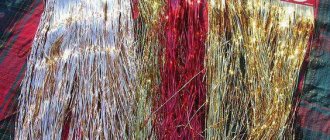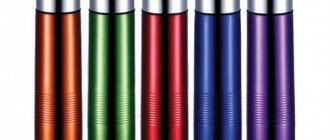Good day! Today I want to show you my version of making a large compass.
What inspired me to create this instrument was that sometimes I had to draw circles, semicircles, medium and large diameters, an ordinary compass could no longer cope with this, and I had to invent something, so it was then that I decided to make myself a tool!
I wanted to look at ready-made options in stores, but to my surprise I didn’t find them at all, there were simply no large compasses, but I’m sure that even if they were, the price tag most likely didn’t suit me, so I started making it.
DIY compass
Many homemade projects require circle markings. Their diameter varies greatly: from just a couple of centimeters to a meter or more. You can spend a lot of time finding suitable compasses. The old method of marking using thread does not give the best results - the circles turn out crooked. The compass, which we propose to make with your own hands from scrap materials, is universal. With its help, you can easily draw a circle and you can also easily change its diameter. Details of the assembly of this wonderful compass are further in the master class.
Materials
Before starting work, prepare:
- meter threaded rod M10;
- washers, 4 pcs.;
- nuts M10, 4 pcs.;
- nut M12, 1 pc.;
- screw;
- epoxy adhesive.
Step 1
. The needle for a homemade compass will be a screw. It needs to be attached using epoxy glue to one of the outer edges of the large nut. For ease of operation, you can clamp the nut itself in a vice. When gluing parts, do not rush. The self-tapping screw must be strictly perpendicular to the nut. It will take about 4 days for the glue to dry completely.
Materials and tools
To make a compass I needed the following:
Material:
- round rail 2 pieces of 35 cm each;
- 2 canopies for attaching hanging shelves (length 7 cm);
- anchor with skirt diameter 12 mm;
- 1 rivet;
- 2 bolts 4 mm, 2 nuts;
- 2 bolts 6 mm, 1 cap nut, 1 wing nut;
- 5 washers, 2 growers;
- piece of plexiglass 26 cm.
Tool:
- saw;
- screwdriver;
- ruler, pencil.
Possibility to make a tool with your own hands
A simple version of the dash is made from thick diameter wire. A similar solution is to drive two long nails into a suitable wooden handle. A mechanic's compass is also used to mark wood. The accuracy of drawing increases as the distance between the teeth of the tool decreases; skill and experience play an important role.
The scriber is a mechanical compass with a built-in level. The latter is intended for precise marking of lines horizontally and vertically. If everything is done correctly, then marking with your own hands will allow you to assemble the log house in such a way that it will not be possible to push a match between the logs. Scriber is an advanced carpentry trait that has been given two levels. This saved time for the carpenter. After all, now they don’t draw a rough line for marking, but immediately draw a finishing mark.
About the shortcomings of my compass
- the legs of the compass do not compress completely due to the heads of the bolts, the needles do not close to zero, about 1 cm remains, i.e. The compass cannot draw very small circles, less than 1cm. This can be solved by increasing the width of the upper bracket so that the legs of the compass are attached at a greater distance from each other, but for myself I decided that I did not need circles less than 1 cm in diameter;
- The thickness of the profile pipe was not chosen very well, because... it only includes an M8 bolt (if you use an M10 bolt, there will already be 2.5 mm left to the edges of the profile), in which you have to drill a 3 mm hole and when the nuts are tightly tightened, the bolt breaks in a thin place. I recommend using a 20 mm profile, into which you can safely insert an M10 bolt, which will increase the strength of the needles. But in my case, the tightening force is enough for the bolts to hold; one needle fastening bolt broke only when I decided to tighten it quite tightly with 2 wrenches: unsure:
- This compass can only be drawn with needles and not with a pencil, but for marking circles on wood and sheet steel it is much more convenient to use a needle (the result is a thin and precise line that is clearly visible) rather than a pencil. If desired, you can make devices for attaching a pencil to this compass.
Otherwise, the compass turned out great and is already helping me in my work. It is possible that in the future I will make a compass version 2.0, where I will take into account all the shortcomings of the first version.
Features of the carpenter's trait
Working with a carpenter's mark requires care, as the scratch cannot be erased like a pencil mark. Another work that is done with the help of a carpenter's line is the cutting of a longitudinal groove for a tight connection of logs in a wall frame, the bowl of a log, before subjecting it to the final processing. The line is used for beating and drawing an even line on the block when planing, processing the boards for their tight fit. The tool is used for marking joints and various marks in carpentry. At the same time, a carpenter's compass is used.
In ancient Russia, when cutting down the walls of houses and churches, carpenters used only an ax and a line. To connect the logs, unique grooves were used that did not require the use of a chisel and chisel. This demonstrated the individual methods of skillful work of ancient masters.
Subsequently, in wood finishing, the line was replaced by a surface planer, which translated from German means a device for drawing parallel straight or winding lines. This tool is used to copy dimensions from one shape to another part. The difference between the two devices is that instead of a wedge and a line ring, the thicknesser has a moving block with a screw lock.
Drawing principle
The process of drawing crowns during the installation of walls requires the special skill of a specialist, because the quality of the constructed log house depends on his precise work. Deviations vertically and horizontally when drawing lines are unacceptable; moreover, in the process of work they first make rough markings, then the final clean drawing.
It takes a carpenter to make a quality log house . Currently, the carpentry trait has been improved, and an almost new tool has emerged, which is called a scriber. Drawing contains the following steps:
- installation of the log of the upper belt, adjustment of the horizontal level on the linings, alignment of the vertical axis of the ends;
- after this comes the drawing stage, which consists in spreading the ends of the scissors to a certain distance, taking into account the thin end of the log, this is done this way, because if you start with a thick butt, then the longitudinal groove may not reach the narrow section;
- You need to draw a line along the level, therefore, moving the needle and pencil to the lower end and the upper, respectively, looking at the bubbles in the device, move the scriber along the log. The same method is used to draw cups.
Life is easier
Well, where would we be without mobile phones? In general, smartphones can greatly simplify life. Fortunately, mobile software developers do not forget about schoolchildren. You just need to install a mobile application to facilitate the learning process, for example, PhotoMath. This is a kind of calculator. We point the lens at the equation that is causing difficulty, and the application immediately provides an answer with a step-by-step solution to the problem. We tested the application on several problems from the 10th grade textbook. All the answers agreed. It’s a pity, in my school years this application did not exist; I had to struggle with discriminants and logarithms on my own. “We take out double leaves. Test!" - this phrase will terrify even the biggest nerd. How to carefully unfasten a double sheet without ruining your manicure? We take the rod out of the pen and carefully pry up the paper clip with the empty nose. Now the leaf can be easily removed without tearing.
Forgot your compass at home? We fasten two pencils at the top with a paper clip, insert an eraser between them and draw perfectly even circles.
Two life hacks for the text highlighter at once. Problem one: it's too bright. We dip the highlighter in warm water - and now it leaves a lighter mark. The life hack works. To celebrate, we emphasized too much and now we want to remove these yellow stripes in the textbook. Take a cotton swab, moisten it with lemon juice - and voila! There is not a trace left of the text highlighter in the textbook! By the way, we were able to revive the dried marker using a regular antiseptic, which now, in the context of coronavirus, is in every schoolchild’s backpack. We take out the plug, take out the rod and spray it on both ends with an antiseptic. Now the marker will live for some more time.
Draw circles of different sizes without auxiliary objects
What to do if you need to draw circles of different diameters?
It is not at all difficult to cope with this problem, having only paper and a simple pencil on hand.
Take a pencil in one hand and place the other on a piece of paper. Place the little finger of your first hand on the sheet so that it is the center of the future circle. Hold this position well. With your other hand, start turning the paper around your little finger. You will see how a smooth circle is obtained, just like when using a compass.
Carpentry Feature Improvement
Time works to improve the instrument and does not stand still. When drawing markings, the main thing is to ensure horizontal and vertical compliance with the line; for this, the ends of the carpenter's line are set using level bubbles. A Canadian inventor proposed an innovation in the form of a marking tool based on a carpenter's line, which he called a scriber. The Russian skilled carpenter did not further elaborate and developed a different version of the scriber, which later became known as the carpenter’s compass.
Vernier caliper design
Shown in Fig. 1 caliper type ШЦ-1 consists of:
- Barbells.
- Framework.
- Measuring scale.
- Upper lips.
- Lower lips.
- Depth gauge.
- Vernier scales.
- Clamping screw.
The choice of caliper for a specific task is determined by the dimensions, design features of the part and requirements for dimensional accuracy. The tools differ in the following parameters:
- Measuring range . The length of the scale on the rod ranges from 125 to 4000 mm.
- Accuracy . Common modifications have an error of 0.1, 0.05, 0.02 and 0.01 mm.
- Functionality . There are calipers with and without a depth gauge.
- The number and shape of measuring surfaces. The jaws of single-ended and double-ended instruments are available in flat, pointed or rounded shapes.
- The design of the reading device . It can be vernier, mechanical, clock type or electronic.
Vernier calipers are made of wear-resistant tool steels, and their measuring surfaces can be reinforced with carbide tips. To mark parts, cutters are installed on non-sharpened jaws (Fig. 2), complete with holders and clamping screws.
How to fix a compass at home. Compass made from scrap materials
Good day! Today I want to show you my version of making a large compass.
What inspired me to create this instrument was that sometimes I had to draw circles, semicircles, medium and large diameters, an ordinary compass could no longer cope with this, and I had to invent something, so it was then that I decided to make myself a tool!
I wanted to look at ready-made options in stores, but to my surprise I didn’t find them at all, there were simply no large compasses, but I’m sure that even if they were, the price tag most likely didn’t suit me, so I started making it.
Taking measurements
When carrying out work, care must be taken, since the measuring bases of the device's jaws have dangerous edges. To determine the external size of the element, press it tightly between the main jaws located below. In this case, the tool must be held in the right hand, four fingers should wrap around the bar, while the thumb should be placed on the frame. The frame should be moved with your thumb, and after reaching the desired pitch between the jaws that mate with the base being measured, it is secured with a clamp.











